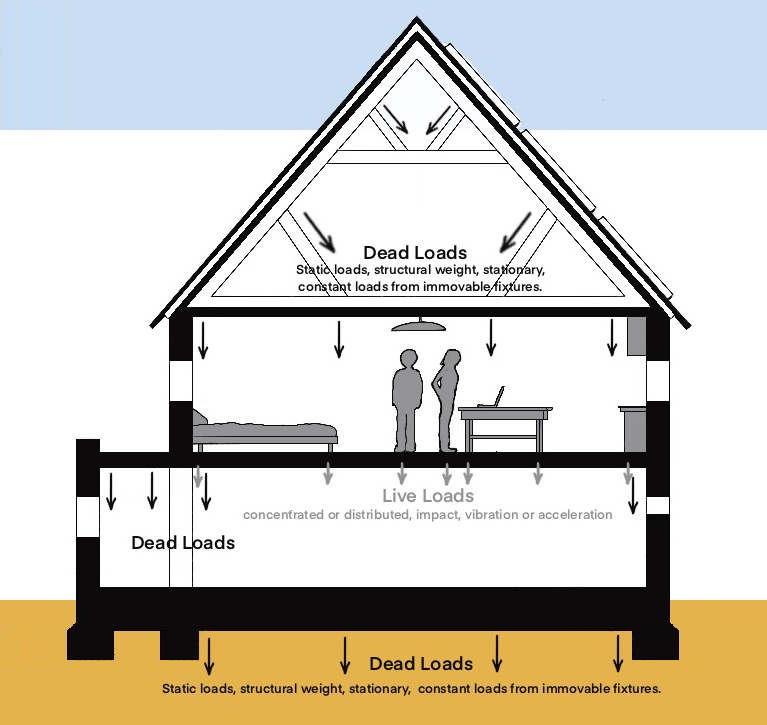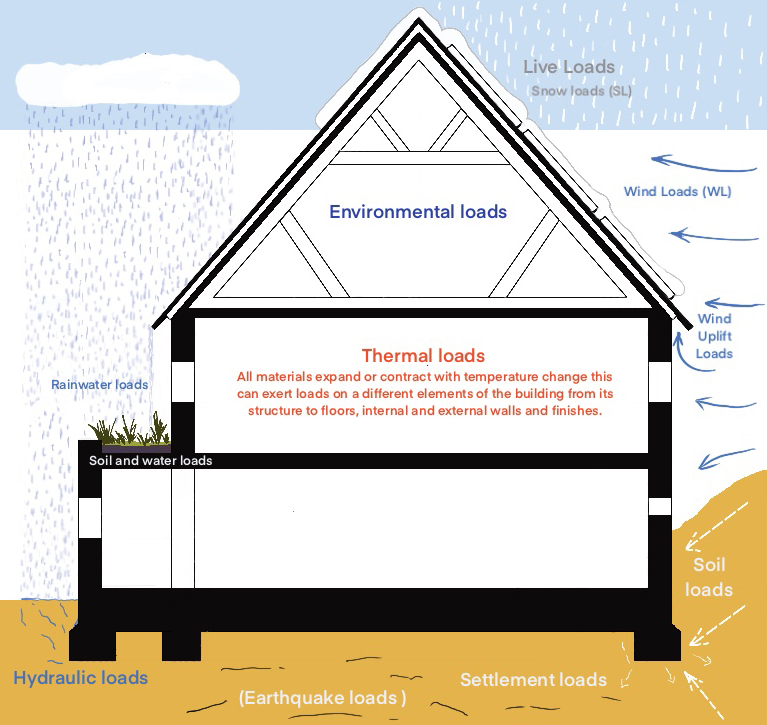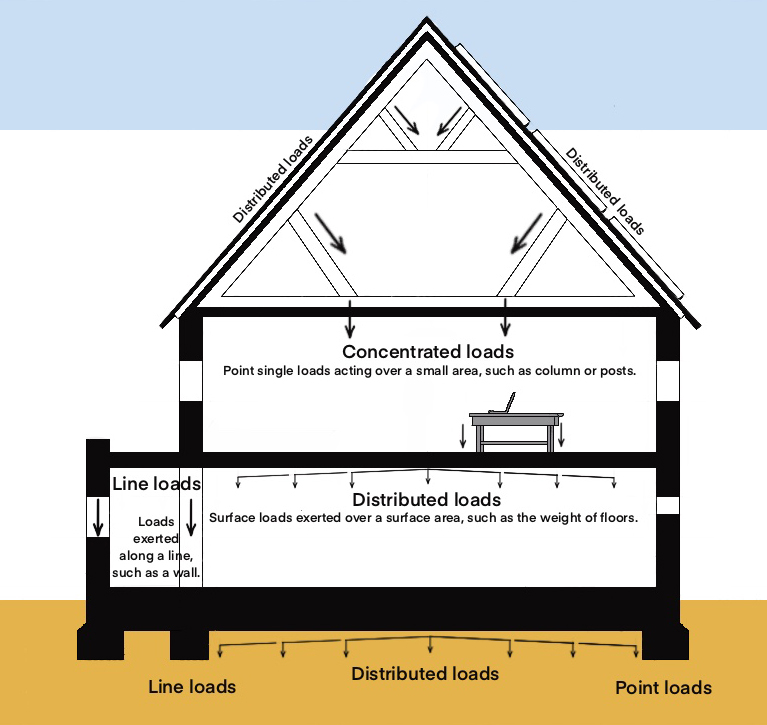Types of structural load
[edit] What are structural loads?
The term 'structural load' refers to forces acting on the structural components of built assets such as a buildings.
Structural analysis is a very important part of the design of buildings and other built assets such as bridges and tunnels, as structural loads can cause stress, deformation and displacement that may result in structural problems or even failure.
The building regulations require that structures must be designed and built to be able to withstand all load types that they are likely to face during their lifecycle. Design requirements are generally specified in terms of the maximum loads that a structure must be able to withstand.
See also: Force.
[edit] What are the different types of structural load?
There are a number of different types of load than can act on a structure, the nature of which will vary according to the design, use, location and materials being used within, or imposer on the structure.
Loads are generally classified as either dead loads (DL) or live loads (LL):
- Dead structural loads remain relatively constant, such as the structure's self weight.
- Live structural loads may vary such as traffic loads.
- Environmental structural loads.
- Concentrated structural loads.
- Structural line loads.
- Distributed structural loads.
[edit] Dead loads (DL)
Dead loads, also known as permanent or static loads, are predominantly associated with the weight of the structure itself, and as such remain stationary and relatively constant over time. Dead loads may include the weight of any structural elements, permanent non-structural partitions, immovable fixtures such as plasterboard, built-in cupboards, and so on.
Dead loads can be calculated by assessing the weights of materials specified and their volume as shown on drawings. This means that in theory, it should be possible to calculate dead loads with a good degree of accuracy. However, structural engineers are sometimes conservative with their estimates, minimising potential deflections, allowing a margin of error and allowing for alterations over time, and so design dead loads often far exceed those experienced in practice.
For more information see: Dead loads.
[edit] Live loads (LL)
Live loads, also known as imposed loads, are usually temporary, changeable and dynamic. These include loads such as vehicle traffic, occupants, furniture and other equipment. The intensity of these loads may vary depending on the time of day, for example an office building may experience increased live loads during week-day work hours but much smaller loads during the night or at weekends.
Live loads may be concentrated or distributed and may involve impact, vibration or acceleration.
For more information see: Live load
[edit] Environmental structural loads
Environmental structural loads, may act on a structure as a result of topographic or weather conditions. Note this maybe shortened to environmental loads in the context of discussing structures, there are many other environmental loads that act on a building though some of which have a lesser impact on structural loads but none the less impact the buildings performance and comfort levels, these might be terms as environmental factors. In turn these should not be confused with environmental impacts which is more likely to describe sustainability issues surrounding the use of materials, energy performance, waste, biodiversity impacts etc.
Wind load (WL)
Wind loads can be applied by the movement of air relative to a structure, and analysis draws upon an understanding of meteorology and aerodynamics as well as structures. Wind load may not be a significant concern for small, massive, low-level buildings, but it gains importance with height, the use of lighter materials and the use of shapes that my affect the flow of air, typically roof forms. Where the dead weight of a structure is insufficient to resist wind loads, additional structure and fixings may be required.
A building's design wind speed is usually determined from historical records using extreme value theory to predict unusual wind speeds that may occur in the future.
Particular effects that may need to be considered might include:
- Corner streams or jets that occur around the corners of buildings.
- Vortex shedding that occurs in the wake of a building.
- Through-flow, or passage jets, that occur in a passage through a building or small gap between two buildings.
In complex situations, it may be necessary to undertake wind tunnel testing of building forms to assess the change in air flows caused by the presence of a structure. Increasingly, analysis is also possible using computational fluid dynamics software.
[edit] Snow load (SL)
This is the load that can be imposed by the accumulation of snow and is more of a concern in geographic regions where snowfalls can be heavy and frequent. Significant quantities of snow can accumulate, adding a sizeable load to a structure. The shape of a roof is a particularly important factor in the magnitude of the snow load. Snow falling on a flat roof is likely to accumulate, whereas snow is more likely to fall of a steeper the roof pitch
This may be similar issues in areas of heavy rainfall where ponding may occur.
[edit] Earthquake load
Significant horizontal loads can be imposed on a structure during an earthquake. Buildings in areas of seismic activity need to be carefully analysed and designed to ensure they do not fail if an earthquake should occur.
[edit] Thermal loads
All materials expand or contract with temperature change and this can exert significant loads on a structure. Expansion joints can be provided at points on long sections of structures such as walls and floors so that elements of the structure are physically separated and can expand without causing structural damage.
[edit] Settlement loads
Stresses can occur in buildings if one part settles more than another. A flexible structure will be able to accommodate the small stresses, whereas a stiff structure will need careful design to alleviate the more severe stresses that may be exerted.
[edit] Concentrated loads
Concentrated loads (or point loads) are single loads that act over a relatively small area, such as column loads.
[edit] Line loads
Line loads are loads exerted along a line, such as a wall.
[edit] Distributed loads
Distributed (or surface) loads are loads exerted over a surface area, such as the weight of floors.
[edit] Triangular load
A triangular loads is a load that varies along a length proportionally increasing, it is also referred to as a uniformly varying load
[edit] Coupled loads
Coupled loads are less common in buildings but may be relevant in some cases, they describe equal but opposite forces that might act on the same span, resulting in turning or spin if not in balance. For example if on one side of a beam a downward force is applied and on the other side of a beam an upward force of the same amount is applied, the loads are referred to as coupled loads.
[edit] Other meanings of load
'Load' is also a general term for anything that consumes electricity.
[edit] Related articles on Designing Buildings
- Bearing capacity.
- Bending moment.
- Biaxial bending.
- Concept structural design of buildings.
- Dead loads.
- Defects in construction.
- Detailed structural design.
- Earthquake Design Practice for Buildings.
- Elastic limit.
- Elements of structure in buildings.
- Floor loading.
- Force.
- Lateral loads.
- Limit state design.
- Live loads.
- Load bearing.
- Load-bearing wall.
- Moment.
- Point load.
- Point of contraflexure.
- Safe working load.
- Settlement.
- Shear force.
- Stiffness.
- Structural engineer.
- Structural steelwork.
- Subsidence.
- The design of temporary structures and wind adjacent to tall buildings.
- Uniformly Distributed Load.
- Uplift force.
- Vibrations.
[edit] External references
Featured articles and news
Moisture, fire safety and emerging trends in living walls
How wet is your wall?
Current policy explained and newly published consultation by the UK and Welsh Governments.
British architecture 1919–39. Book review.
Conservation of listed prefabs in Moseley.
Energy industry calls for urgent reform.
Heritage staff wellbeing at work survey.
A five minute introduction.
50th Golden anniversary ECA Edmundson apprentice award
Showcasing the very best electrotechnical and engineering services for half a century.
Welsh government consults on HRBs and reg changes
Seeking feedback on a new regulatory regime and a broad range of issues.
CIOB Client Guide (2nd edition) March 2025
Free download covering statutory dutyholder roles under the Building Safety Act and much more.
AI and automation in 3D modelling and spatial design
Can almost half of design development tasks be automated?
Minister quizzed, as responsibility transfers to MHCLG and BSR publishes new building control guidance.
UK environmental regulations reform 2025
Amid wider new approaches to ensure regulators and regulation support growth.
The maintenance challenge of tenements.
BSRIA Statutory Compliance Inspection Checklist
BG80/2025 now significantly updated to include requirements related to important changes in legislation.
Shortlist for the 2025 Roofscape Design Awards
Talent and innovation showcase announcement from the trussed rafter industry.
OpenUSD possibilities: Look before you leap
Being ready for the OpenUSD solutions set to transform architecture and design.
Global Asbestos Awareness Week 2025
Highlighting the continuing threat to trades persons.
Retrofit of Buildings, a CIOB Technical Publication
Now available in Arabic and Chinese as well as English.






























Comments
[edit] To make a comment about this article, click 'Add a comment' above. Separate your comments from any existing comments by inserting a horizontal line.
Some diagrams would be really useful.